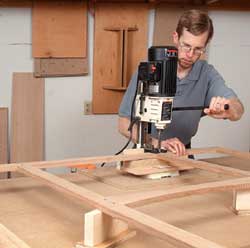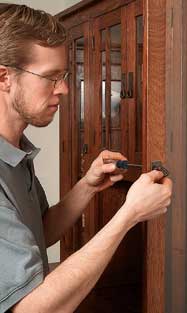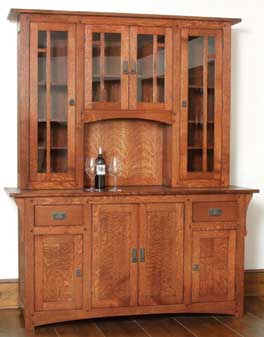
Chris Marshall is a familiar name to readers of both print and online versions of Woodworker’s Journal. Over the past 12 years, he’s established himself as a uniquely accessible author of articles and books on woodworking and home improvement projects. Working from a shop in his garage — like a lot of woodworkers — Chris has carved out a living as a successful writer and woodworker & a combination coveted by many, but attained by only a few.
It started as a hobby for the Twin Cities native back in junior high. He loved the creative process of building with wood, and he’s had some sort of project going ever since. But he also found enjoyment in writing down a description of what he was building. After college he started working in publishing, but his two interests started coming together in 1996 when he went to work for a home improvement publisher.
“That’s when I first had a chance to develop my editorial background into do-it-yourself articles and books,” Chris recalled, “and it evolved into specializing in the woodworking field.”
Chris worked for two years on a home improvement magazine, then another three years editing and writing books on home improvement and woodworking topics.
Then, shortly after moving to Ohio three years ago, Chris took on the role of contributing editor at Woodworker’s Journal. His articles have ranged from tool comparisons and reviews, to the design and construction of furniture and workshop projects, to editing articles submitted by other correspondents. Along the way, he’s authored five books on woodworking for various publishers and contributed to several others. The process for completing each assignment varies, but Chris always puts himself in the shoes of the reader.
“I approach articles and books like I hope most any reader would,” Chris explained, “with my own questions about how things work. I don’t pretend to know it all, and it is a learning process even for me. If a reader wants to buy a table saw, but doesn’t have time for researching all of them, I’ll help them figure out the best buy. I want to be an advocate for readers.”
“For a project article I usually have a pencil and paper design or occasionally the magazine’s art department might come up with the initial design. I noodle through it and write up some abbreviated step-by-step instructions. But the only true test for how to build something is to just build it! I let the materials and the methods play into how things go together and make lots of notes as I build. It’s only after I’ve finished a prototype that I draft the actual step-by-step procedure for putting the project together.

“Sometimes I’ve already built a project, and I offer it to Woodworker’s Journal as a potential story. I send photographs of those features I think will be appealing to readers & showing an important piece of hardware, a special jig, or a technique worth trying.”
Chris just finished writing a couple of books to help launch a new woodworking series for another Twin Cities-based publisher. One focuses on table saw use and the other is a woodworking basics book. Writing projects come his way because publishers already know the tone and breadth of his work.
“I’ve been lucky finding a niche in woodworking publishing, but I still do some home improvement writing on broader topics and lately on tool and product reviews. But the writing I enjoy the most is the woodworking writing.”
Chris is currently lining up products for a review on dado blades for an upcoming issue of Woodworker’s Journal.
“When I do a product comparison, I’ve tested every tool that appears in the article against each other. With the editor’s consultation, I devise a series of tests that produce the kind of information that will make sense to a reader. Usually it’s not a matter of determining .0005 tolerances, but whether or not the tool performs its task well. I ask questions like, Does it makes clean cuts? Can it be set up reliably with repeatable results? And is it a good value for the money?”
One of Chris’s favorite projects was a large Arts & Crafts wine cabinet created as a commission piece that also appeared in an article in the July/August 2003 issue of Woodworker’s Journal.

“The wine cabinet was interesting because it was very labor intensive and probably the largest project I have ever built. It started with a Twin Cities designer, Richard Stevens. I took his sketch of the front view and, working with the client, I figured out how to make it all work from a construction standpoint. I built it and wrote it up and had all the photos taken here during one of the coldest, snowiest Ohio winters in history. It was a long, cold winter in my garage shop last year.”
Chris would like to do more commissioned pieces. Not only are they more profitable, but he also enjoys working with people who have their own ideas and need a piece of furniture that functions in a certain way, has a particular style, and fits into a certain space. Otherwise, most of the pieces he’s created for articles have been needed around Chris’s house or, in the case of jigs and fixtures, found a home in his shop.
Not one to rest on his laurels, Chris sets the bar high for every article.
“You are only as good as your last job.” Chris explained, “I have to be happy with the story, but it also has to satisfy the reader’s needs. Writing has been my avenue to get into woodworking and stay there. I wouldn’t enjoy it as much if I had to do only writing or only woodworking. I like both parts of the process!”





